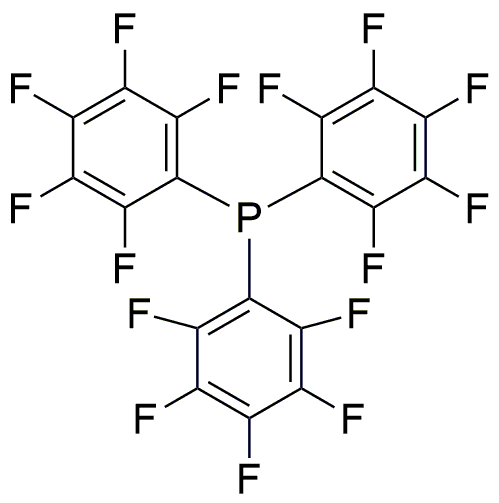Tris(pentafluorophenyl)phosphine is widely utilized in research focused on:
- Organic Synthesis: This compound serves as a powerful reagent in organic chemistry, particularly in the synthesis of complex molecules, due to its ability to stabilize reactive intermediates.
- Phosphine Ligands: It is commonly employed as a ligand in transition metal catalysis, enhancing the efficiency of reactions like cross-coupling and hydrogenation, which are crucial in pharmaceuticals and materials science.
- Fluorinated Materials: The unique properties of this chemical make it valuable in developing fluorinated polymers and materials, which are known for their chemical resistance and thermal stability.
- Analytical Chemistry: It is used in various analytical techniques, including NMR spectroscopy, to improve the detection and characterization of compounds, benefiting researchers in both academic and industrial settings.
- Environmental Applications: The compound's properties allow it to be explored in the development of sensors for detecting pollutants, aiding in environmental monitoring and protection efforts.
General Information
Properties
Safety and Regulations
Applications
Tris(pentafluorophenyl)phosphine is widely utilized in research focused on:
- Organic Synthesis: This compound serves as a powerful reagent in organic chemistry, particularly in the synthesis of complex molecules, due to its ability to stabilize reactive intermediates.
- Phosphine Ligands: It is commonly employed as a ligand in transition metal catalysis, enhancing the efficiency of reactions like cross-coupling and hydrogenation, which are crucial in pharmaceuticals and materials science.
- Fluorinated Materials: The unique properties of this chemical make it valuable in developing fluorinated polymers and materials, which are known for their chemical resistance and thermal stability.
- Analytical Chemistry: It is used in various analytical techniques, including NMR spectroscopy, to improve the detection and characterization of compounds, benefiting researchers in both academic and industrial settings.
- Environmental Applications: The compound's properties allow it to be explored in the development of sensors for detecting pollutants, aiding in environmental monitoring and protection efforts.
Documents
Safety Data Sheets (SDS)
The SDS provides comprehensive safety information on handling, storage, and disposal of the product.
Product Specification (PS)
The PS provides a comprehensive breakdown of the product’s properties, including chemical composition, physical state, purity, and storage requirements. It also details acceptable quality ranges and the product's intended applications.
Certificates of Analysis (COA)
Search for Certificates of Analysis (COA) by entering the products Lot Number. Lot and Batch Numbers can be found on a product’s label following the words ‘Lot’ or ‘Batch’.
Numéro de catalogue
Numéro de lot/série
Certificates Of Origin (COO)
This COO confirms the country where the product was manufactured, and also details the materials and components used in it and whether it is derived from natural, synthetic, or other specific sources. This certificate may be required for customs, trade, and regulatory compliance.
Numéro de catalogue
Numéro de lot/série
Safety Data Sheets (SDS)
The SDS provides comprehensive safety information on handling, storage, and disposal of the product.
DownloadProduct Specification (PS)
The PS provides a comprehensive breakdown of the product’s properties, including chemical composition, physical state, purity, and storage requirements. It also details acceptable quality ranges and the product's intended applications.
DownloadCertificates of Analysis (COA)
Search for Certificates of Analysis (COA) by entering the products Lot Number. Lot and Batch Numbers can be found on a product’s label following the words ‘Lot’ or ‘Batch’.
Numéro de catalogue
Numéro de lot/série
Certificates Of Origin (COO)
This COO confirms the country where the product was manufactured, and also details the materials and components used in it and whether it is derived from natural, synthetic, or other specific sources. This certificate may be required for customs, trade, and regulatory compliance.


